In the context of the rapidly growing culinary and food service industry, investing in industrial kitchen equipment for a canteen […]
Read more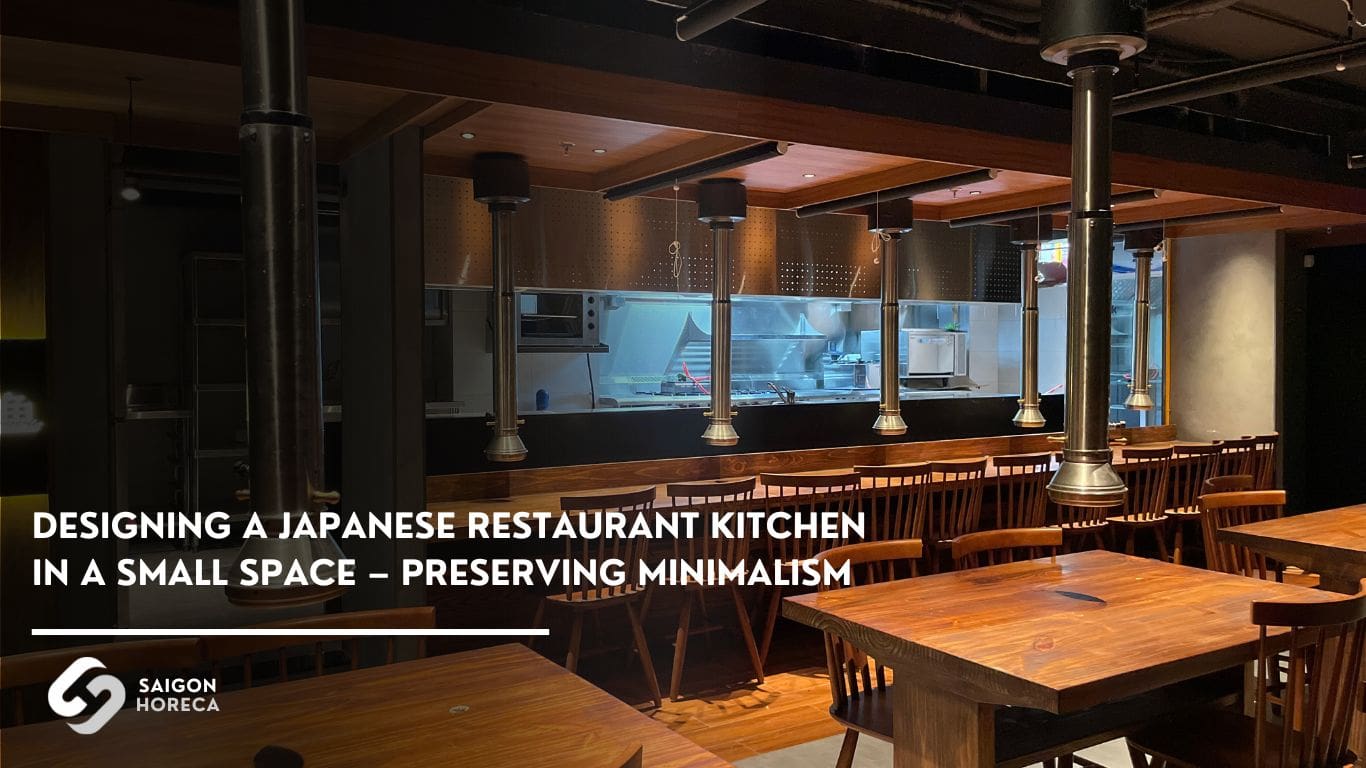
- News
Designing a Japanese Restaurant Kitchen in a Small Space – Preserving Minimalism
- June 27, 2025
When it comes to “minimalism,” many people imagine a tidy, sparse space that feels calm and relaxing. But in the world of Japanese restaurant kitchens, minimalism isn’t just about visual simplicity – it’s a strict operational philosophy where every tool, every movement is calculated to serve efficiency, cleanliness, and respect for the ingredients’ original value.
In reality, many Japanese restaurants today operate in limited spaces – sometimes only 20 to 30 square meters for the entire kitchen. However, this doesn’t reduce the quality of food or the customer experience, as long as the layout is well-thought-out from the start.
So, how can we maintain the true Japanese minimalist spirit in a small kitchen space?
The answer isn’t about “doing less” but about doing right and doing just enough – from designing the workflow, choosing the right equipment, to managing space. This is exactly what Saigon Horeca has pursued over the years while working with Japanese restaurants in Vietnam.
In this article
Exploring the Challenges of Designing Japanese Restaurant Kitchens in Small Spaces with Experts
Japanese cuisine is known for its subtlety, precision, and strict requirements at every stage of preparation. However, when applying the Japanese restaurant model to a limited space, kitchen layout becomes a tricky problem. Below are the common challenges:
Exploring the Challenges of Designing Japanese Restaurant Kitchens in Small Spaces with Experts
Japanese cuisine is known for its subtlety, precision, and strict requirements at every stage of preparation. However, when applying the Japanese restaurant model to a limited space, kitchen layout becomes a tricky problem. Below are the common challenges:
1. Limited Space but Strict Requirements
Unlike other types of kitchens, a Japanese restaurant kitchen requires separate zones for tasks like live fish preparation (sashimi), sushi rolling, frying (tempura), and cold storage… Each of these zones must be distinct to ensure food safety. In a small space, managing these zones can quickly become tangled.
2. Storing and Preserving Fresh Ingredients
Japanese cuisine emphasizes fresh ingredients, so storage equipment (refrigerators, freezers) is essential. However, these large appliances often take up a lot of space, which can obstruct walkways if not arranged cleverly.
3. Disrupted Workflow
One of the key principles in kitchen design is one-way flow. However, in a cramped space, it’s easy for chefs and assistants to cross paths: from preparation → cooking → plating → cleaning. This disrupts workflow efficiency and safety during operations.
4. Smoke Extraction and Fresh Air Systems
In a small space, installing ventilation systems, exhaust fans, and fresh air intake systems can be challenging. If not addressed properly, the kitchen will feel suffocating, hot, and could cause smells to seep into the dining area – a major issue in Japanese restaurants.
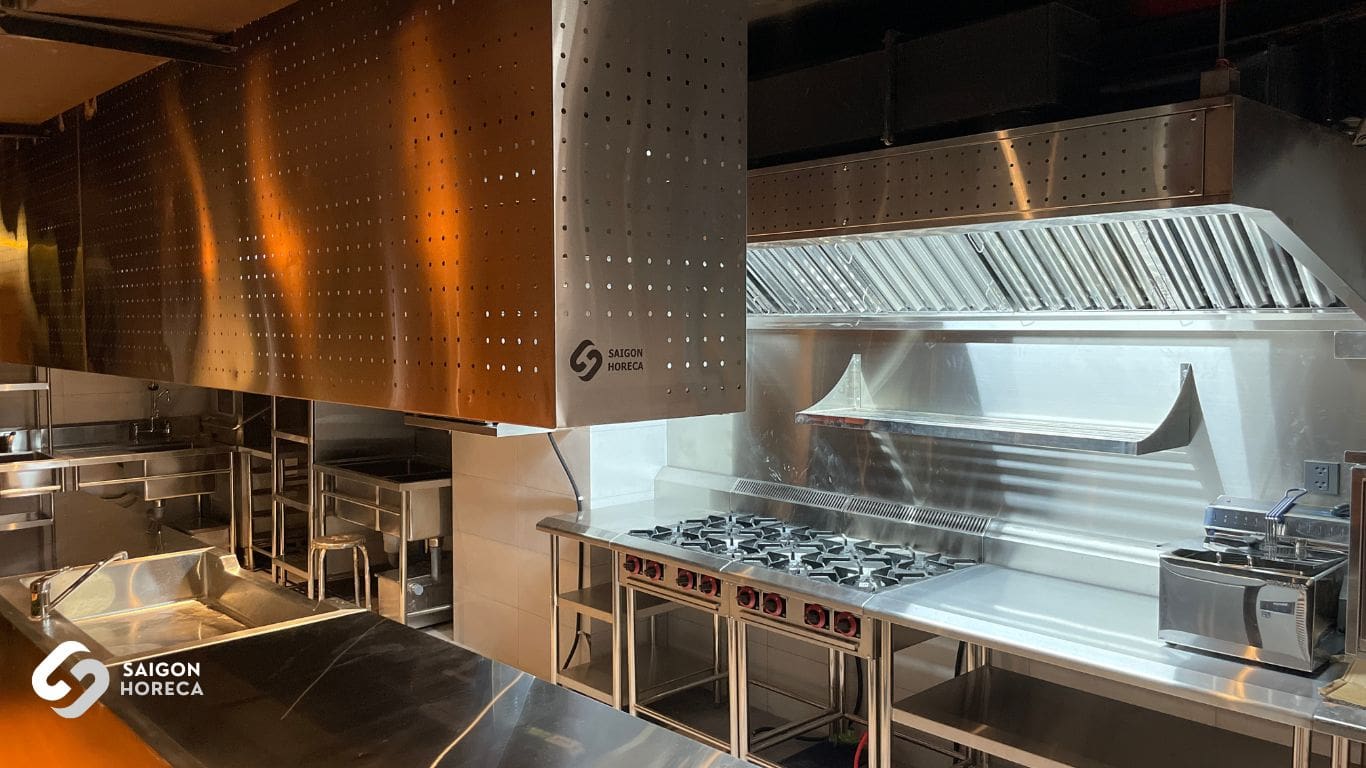
5. Aesthetic Value and Maintaining Minimalism
A tight space often forces owners to “cram” equipment, breaking the minimalist design principle typical of Japanese kitchens. This makes the kitchen feel cluttered and aesthetically inconsistent, which could cause discomfort if customers can view an open kitchen.
What solutions can overcome these challenges while maintaining cleanliness, simplicity, and authenticity in design?
>>> The next section will discuss the principles of designing Japanese kitchens in small spaces and share real-world solutions from Saigon Horeca.
Key Principles When Designing Japanese Kitchens in Small Spaces
When designing a Japanese restaurant kitchen – especially in a limited area – every detail must serve a single goal: high operational efficiency while maintaining simplicity, cleanliness, and perfection. Below are the core principles that any small Japanese kitchen design must adhere to:
1. One-Way Movement Flow – The Golden Rule for Efficient Operations
In a confined space, having two chefs move toward each other creates not only obstacles but also safety risks. Japanese kitchens emphasize orderliness in movement, and the one-way flow principle is non-negotiable.
From receiving ingredients → preparing → cooking → plating → washing, every task must be designed seamlessly in one direction. This ensures:
- Avoiding collisions between staff.
- Speeding up dish preparation time.
- Optimizing counter and floor space.
2. Clear Functional Zoning – The Smaller, the More Scientific
A cramped space does not mean “stuffing everything into one corner.” On the contrary, a Japanese kitchen demands clear functional zoning, even in a small area.
A standard kitchen layout must have at least 4 distinct zones:
- Ingredient reception & preparation area.
- Hot/cold cooking area.
- Plating and final check area.
- Cleaning and post-service area.
When arranged cleverly, these zones can be connected in U or L shapes, optimizing unused corners and ensuring a smooth workflow.
3. Prioritize Multi-Function and Wall-Mounted Equipment – A Smart Space Solution
With a space under 30m², each piece of equipment must be carefully selected. Multi-functional equipment such as a refrigerated prep table that doubles as a workspace is an ideal choice.
Additionally, wall-mounted or built-in equipment helps free up floor space, creating a more spacious feeling and making work more convenient:
- Under-counter refrigerators.
- Wall-mounted stainless steel shelves.
- Electrical cabinets and control panels hidden in technical compartments.
4. Inox 304 Material – Easy to Clean, High Durability
In a small kitchen, cleaning must be quick and thorough to avoid odors and bacteria buildup. Therefore, inox 304 is always the first choice for equipment and surfaces in Japanese kitchens.
Reasons why:
- Rust-resistant, heat-resistant, easy to clean.
- Does not absorb food odors.
- Complies with food safety standards like HACCP.
5. Ventilation & Smoke Extraction – Don’t Compromise on Cleanliness
One of the hallmarks of Japanese restaurants is direct grilling (yakitori, robatayaki…), meaning smoke, oil, and food smells are inevitable. In a small space, these elements accumulate and negatively impact kitchen operation quality.
Thus, kitchen design must prioritize:
- Smoke extraction and fresh air systems to ensure air circulation.
- Stainless steel exhaust pipes with oil filters to prevent fire hazards and ease maintenance.
When applying these principles correctly, even with limited space, the kitchen can operate smoothly, efficiently, and in line with the minimalist spirit of Japan.
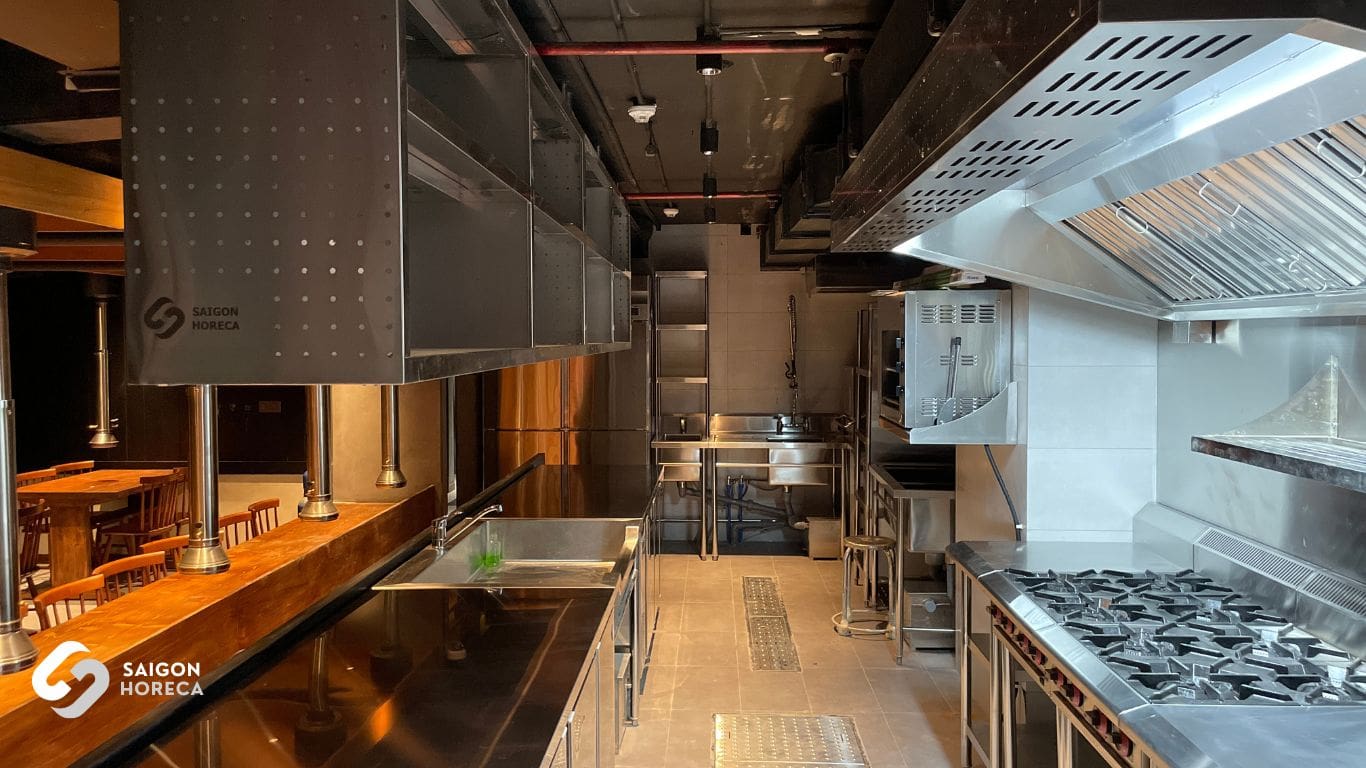
Applying Japanese Design Principles in Kitchen Layouts
Beyond architecture and interiors, the spirit of Japanese restaurant design is reflected in the organization of the kitchen – where space, light, functionality, and ambiance are carefully balanced. When applying Japanese design principles to kitchens, especially in small spaces, Saigon Horeca focuses on three main factors: visual simplicity and high flexibility.
1. Visual Simplicity
A cramped kitchen can feel claustrophobic and disorganized if poorly laid out. In Japanese design, the kitchen must give a sense of lightness and orderliness – helping chefs concentrate, reduce stress, and enhance the quality of their dishes.
To achieve this, design teams often:
- Use flat surfaces, avoiding bulky handles or unnecessary corners.
- Prioritize a uniform stainless steel finish or bright white surfaces to reflect light better.
- Combine natural lighting (if possible) with warm-toned LED lights to create a friendly atmosphere rather than the cold, sterile look typical of industrial kitchens.
- Minimize the number of items on the counter – everything must have its own designated storage space, embodying the “each item has a place” philosophy.
2. Flexibility in Transformation
A unique feature of Japanese restaurants is the varying menu throughout the day – lighter fare during lunch and more elaborate dishes at night. Saigon Horeca has implemented many design solutions that allow the kitchen to flexibly adapt to these demands:
Key design solutions include:
- Mobile prep tables with locking wheels, easily repositioned to change the layout.
- Wall-mounted shelving systems with sliding rails, which can be extended to store ingredients and retracted when not in use.
- Under-counter refrigeration and storage systems for day-to-day operations, utilizing space that’s not needed during busy times.
- Multi-functional equipment such as electric stoves + built-in ovens, saving space while offering flexibility in cooking methods.
The simplicity of the design, the tidiness of the layout, and the flexibility in operation combine to create an effective kitchen ecosystem that reflects Japanese culinary principles. Saigon Horeca has been a trusted partner in designing kitchens for many Japanese restaurants in Vietnam, ensuring that each detail is functional and aesthetically fitting.
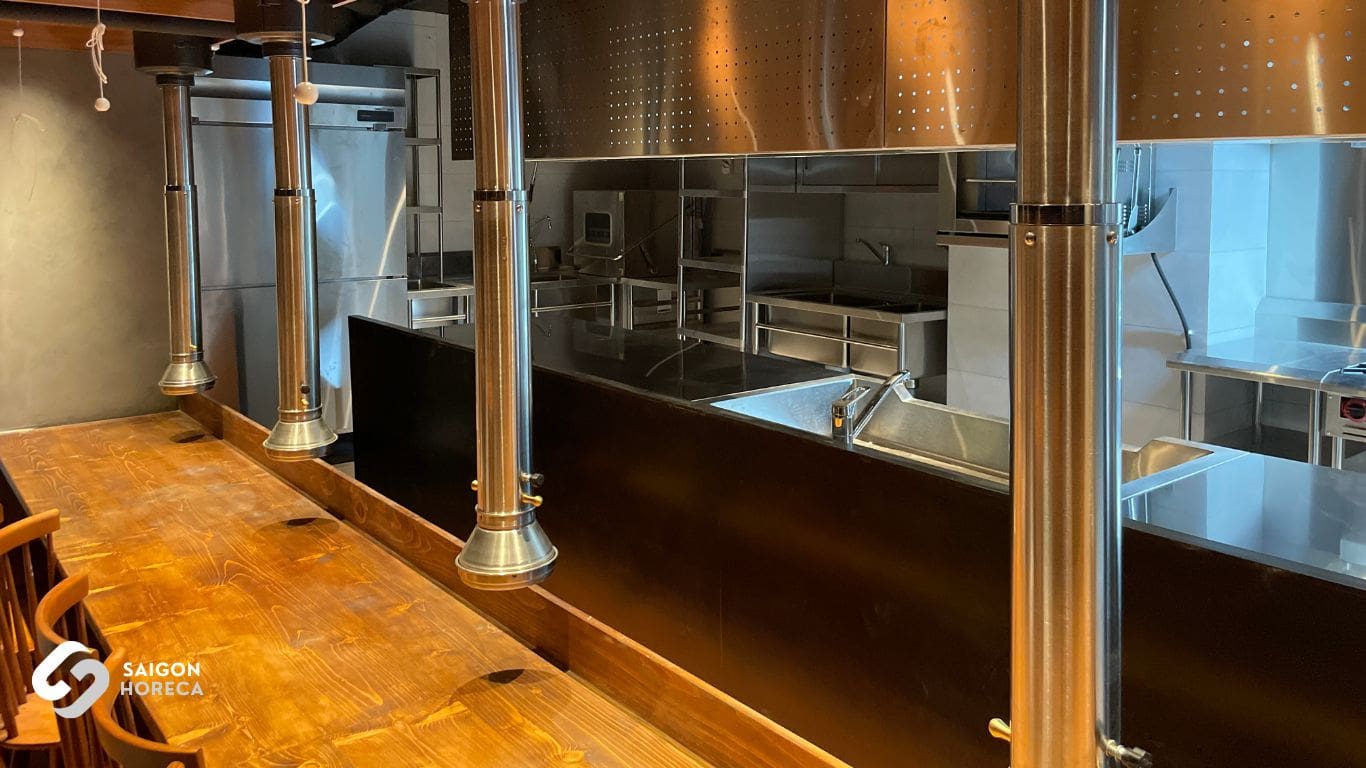
Saigon Horeca’s Contribution to Yakiuo Ishikawa Saigon’s Kitchen Design
With many years of experience designing kitchens for restaurants, Saigon Horeca advised Yakiuo Ishikawa Saigon on optimizing space and functionality for the kitchen. The restaurant required a flexible kitchen that could serve table-side grilling and prepare Omakase dishes quickly and efficiently. This demanded meticulous attention to every detail to meet the restaurant’s needs.
- Supplying specialized kitchen equipment:
Saigon Horeca provided modern, specialized equipment to meet the restaurant’s operational needs, including table-side grilling systems, smoke extraction systems, high-end cold storage, and equipment for Omakase and Meatless Yakiniku preparation.
1. Specialized Table-Side Grilling Systems: Saigon Horeca implemented a customized table-side grilling system to ensure optimal cooking performance and comfort for diners. The smoke extraction system was equipped with an oil filter, making maintenance easy and ensuring that the surrounding area remained clean and free from smoke.
2. High-End Cold Storage Equipment: Saigon Horeca supplied advanced cold storage solutions to keep ingredients fresh. These units were carefully chosen to protect high-quality ingredients like bluefin tuna, a key component in preparing Omakase dishes.
3. Smoke Extraction and Air Circulation Systems: With table-side grilling, smoke extraction systems were essential. Saigon Horeca designed and implemented an adjustable smoke extraction system, ensuring customers weren’t affected by smoke. Additionally, air circulation systems ensured the kitchen remained ventilated, providing an ideal working environment for the chefs.
4. Specialized Washing Stations and Preparation Equipment: Saigon Horeca designed oversized washing stations specifically for bluefin tuna preparation, ensuring food hygiene and workflow efficiency. Stainless steel storage cabinets were mounted on the ceiling to save space and ensure food safety.
5. Dry Storage Units for Bluefin Tuna: Saigon Horeca also provided specialized storage solutions for bluefin tuna, ensuring the fish remained fresh and perfect for Omakase dishes.
- Optimized Kitchen Design Solutions:
The entire kitchen equipment system at Yakiuo Ishikawa Saigon was designed by Saigon Horeca, tailored to the operational needs of the chefs. Each kitchen area was strategically arranged to maximize flexibility and ensure high efficiency.
The table-side smoke extraction system was cleverly designed with an easy-to-remove oil filter, making cleaning and maintenance easier. This not only provided comfort for diners but also ensured a clean and perfect environment for the restaurant.
Every detail in the design was focused on efficiency and operational quality, aligning with the minimalist principles of Japanese cuisine.
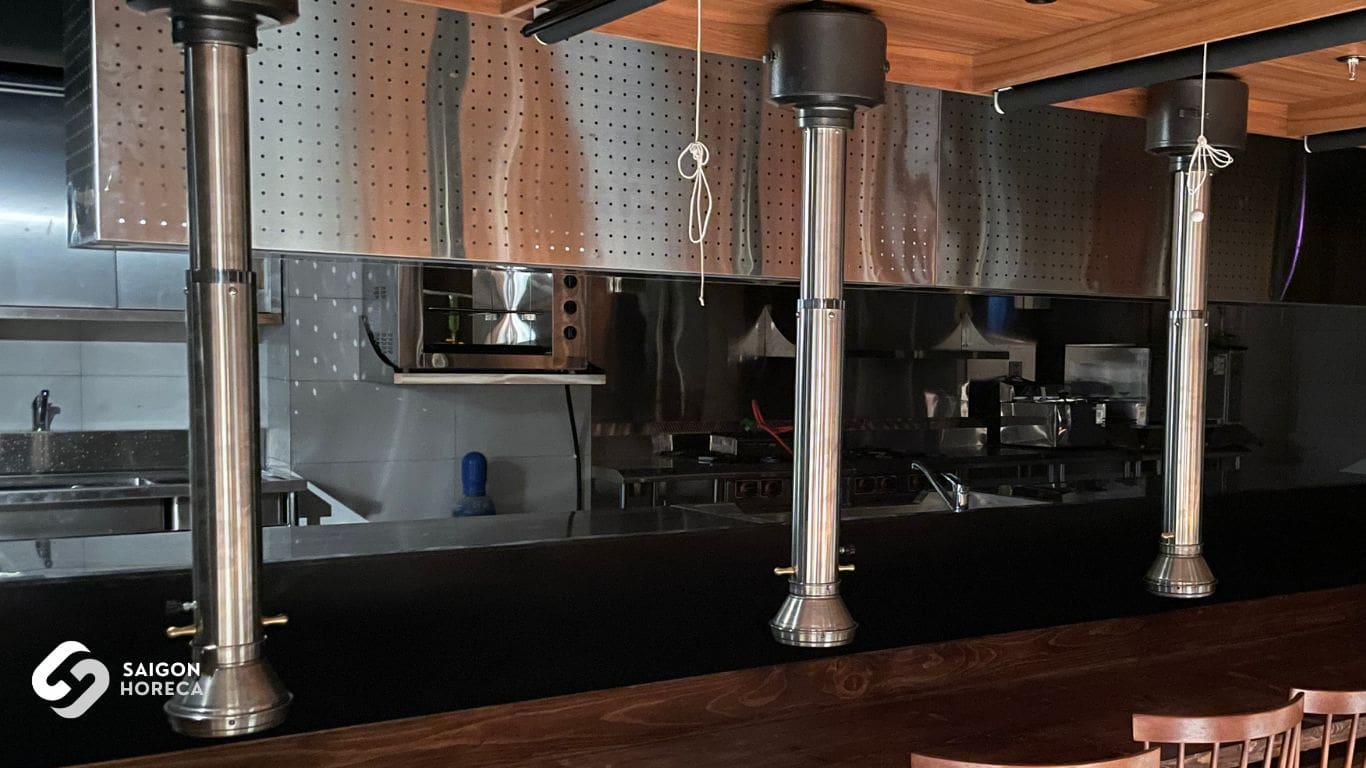
Key Considerations for New Investors in Japanese Restaurants
If you are considering opening a Japanese restaurant – from a small sushi bar, a cozy izakaya, to a robata grill – the kitchen is the “heart” that requires serious investment from the beginning. Here are two important considerations for new investors embarking on the journey of Japanese cuisine:
1. Budgeting for Initial Investment & Cost-Effective Solutions
Avoid “over-purchasing” initially:
For Japanese restaurant models, it’s best to focus investments on core equipment, such as: refrigerated prep tables, Japanese gas stoves, robata grills, Hoshizaki ice makers, and sushi refrigerators. Secondary equipment can be added as operations grow.
Prioritize multi-functional, energy-efficient equipment:
Choose equipment that can serve multiple purposes (e.g., a refrigerated prep table that doubles as a workspace), helping reduce the number of machines needed, saving on both capital investment and energy costs.
Leverage smart design to reduce long-term operating costs:
An efficient kitchen layout will help save on labor costs, cooking time, and utility bills, ensuring long-term profitability.
2. Choose a Design and Construction Partner Experienced with Japanese Models
Many restaurants fail because… the kitchen was designed “just for looks” but lacked functionality.
For Japanese models, you need a partner who:
- Knows the specific cooking processes of Japanese cuisine (sashimi, sushi, tempura, robata…).
- Recommends authentic Japanese equipment suited to your space.
- Designs with clear functionality, clearly separating hot and cold zones, clean and dirty areas, and the bar area.
- Most importantly: optimizes costs without compromising on authenticity.
Saigon Horeca has been a partner in many Japanese restaurant projects – from compact spaces to larger chains – offering a complete package: design – equipment supply – industrial kitchen construction for Japanese standards.
Thứ hai - Thứ sáu
từ 8h00 đến 18h00
Số 40 Đường số 6, KDC Melosa Khang Điền, Phú Hữu, HCM.
Liên hệ ngay
Looking to elevate your grilled dishes with a Salamander Grill? With its ability to grill quickly and evenly while giving […]
Read more




